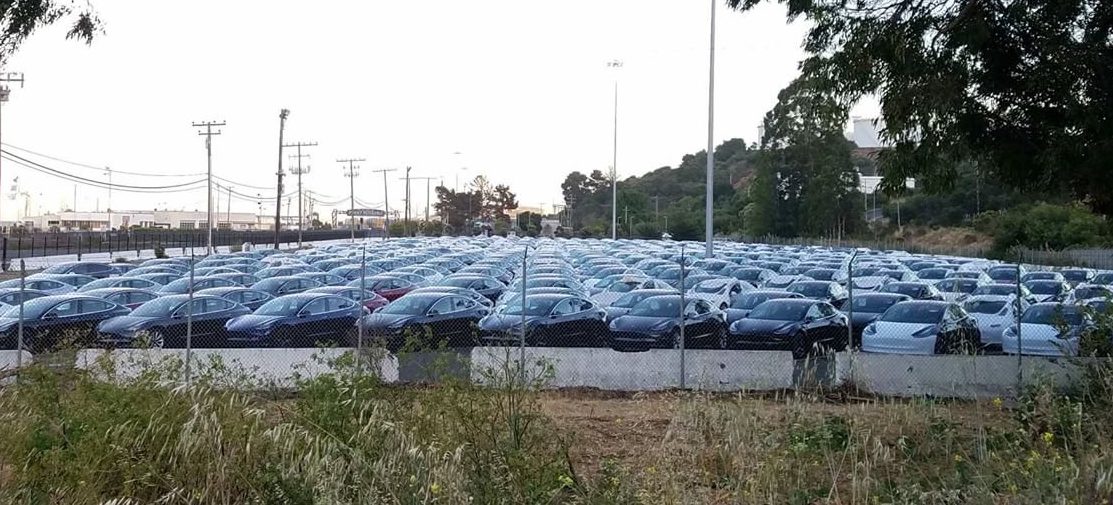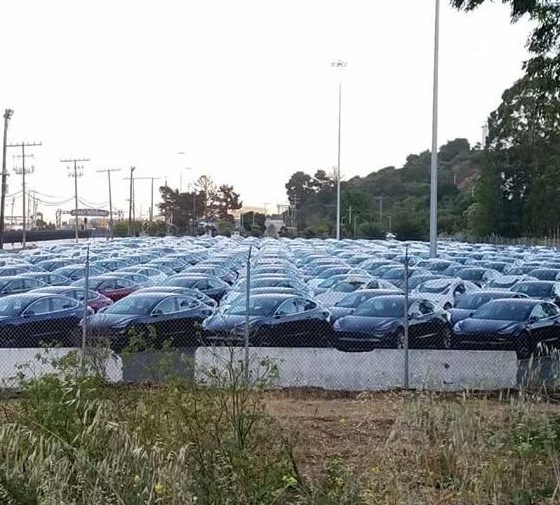

Investor's Corner
Tesla registers more than 6k new Model 3 VINs, estimated ~100% dual motor AWD
Tesla recently registered a large batch of 6,032 new Model 3 VINs, with almost all of the filings corresponding to the Dual Motor AWD variant of the compact electric car. The new vehicle identification registrations come at a time when Tesla is actively pushing its deliveries for the Model 3.
The new batch of Model 3 Dual Motor AWD VINs was reported by Twitter watchdog group @Model3VINs, which tracks Tesla’s registrations for the vehicle. According to the group, Tesla’s recent filing — which numbers 6,032 new VINs that are estimated to be ~100% Dual Motor AWD — has brought the company’s total number of Model 3 registrations to 69,601 units.
#Tesla registered 6,032 new #Model3 VINs. ~100% estimated to be dual motor. Highest VIN is 69601. https://t.co/rVcbmKt2r0
— Model 3 VINs (@Model3VINs) July 11, 2018
This recent filing stands as yet another sign that Tesla is well on its way to sustaining its production rate of 5,000 Model 3 per week this third quarter. The production milestone was finally attained by the company during the final week of June, but it did not escape criticism from the company’s doubters, some of whom predicted that the Model 3’s 5,000/week “burst” production would be unsustainable. These doubts, together with lower than expected Model 3 deliveries revealed in Tesla’s Q2 2018 delivery and production report, ultimately caused the company’s stocks to tumble last week.
Since then, however, signs have emerged pointing to the idea that Tesla would be able to sustain its 5,000/week production rate for the Model 3 this third quarter. Just recently, reports emerged from the Tesla community that the company had rolled out configurator emails to all Model 3 reservation holders. This was followed by an encouraging trend displayed by Bloomberg‘s Model 3 production tracker, which currently forecasts that Tesla would be able to sustain its “burst” production rate of 5,000 vehicles per week for the next three weeks. Bloomberg‘s Model 3 production tracker has become more accurate over the past few months, with the system only being 2% off its estimates for Tesla’s Q2 figures for the compact electric car. With this in mind, there is a pretty fair chance of the tracker’s favorable forecast for Model 3 production would prove to be accurate.
Bloomberg’s Tesla Model 3 tracker as of 7/11/18. [Credit: Bloomberg]
Tesla has also started changing its strategy for the Model 3. Since the vehicle reservations exceeded the company’s estimates, Tesla has embarked on an initiative to anti-sell the compact electric car. CEO Elon Musk, for one, noted on Twitter that the Model 3, while newer than the Model S, is not a superior vehicle. Tesla’s official website also included a table comparing the Model S favorably to the Model 3, both in features and in availability. Despite this anti-selling, however, Model 3 reservations remained high, with Tesla most recently confirming that it still has a backlog of 420,000 orders for the electric car.
With the release of configurator emails for reservation holders and the rollout of programs such as test drives in selected stores, as well as a new 5-minute “Sign & Drive” delivery system, Tesla appears to have stopped anti-selling the Model 3. The Model 3, after all, would likely determine whether Tesla could achieve its target of becoming profitable this third or fourth quarter.
Overall, filings such as today’s batch of 6,032 new Model 3 Dual Motor AWD VINs are encouraging for Tesla. The company, after all, is only producing the Model 3 Performance with Dual Motor AWD for now. Among the Model 3’s variants, the Performance trim, which comes with Dual Motor AWD as default, features a healthy profit margin, with the vehicle starting at $64,000. With this in mind, this newest batch of Model 3 filings, provided that the cars do get delivered this third quarter, could definitely help Tesla’s profitability goals this Q3 2018.

Investor's Corner
Tesla stock closes at all-time high on heels of Robotaxi progress

Tesla stock (NASDAQ: TSLA) closed at an all-time high on Tuesday, jumping over 3 percent during the day and finishing at $489.88.
The price beats the previous record close, which was $479.86.
Shares have had a crazy year, dipping more than 40 percent from the start of the year. The stock then started to recover once again around late April, when its price started to climb back up from the low $200 level.
This week, Tesla started to climb toward its highest levels ever, as it was revealed on Sunday that the company was testing driverless Robotaxis in Austin. The spike in value pushed the company’s valuation to $1.63 trillion.
Tesla Robotaxi goes driverless as Musk confirms Safety Monitor removal testing
It is the seventh-most valuable company on the market currently, trailing Nvidia, Apple, Alphabet (Google), Microsoft, Amazon, and Meta.
Shares closed up $14.57 today, up over 3 percent.
The stock has gone through a lot this year, as previously mentioned. Shares tumbled in Q1 due to CEO Elon Musk’s involvement with the Department of Government Efficiency (DOGE), which pulled his attention away from his companies and left a major overhang on their valuations.
However, things started to rebound halfway through the year, and as the government started to phase out the $7,500 tax credit, demand spiked as consumers tried to take advantage of it.
Q3 deliveries were the highest in company history, and Tesla responded to the loss of the tax credit with the launch of the Model 3 and Model Y Standard.
Additionally, analysts have announced high expectations this week for the company on Wall Street as Robotaxi continues to be the focus. With autonomy within Tesla’s sights, things are moving in the direction of Robotaxi being a major catalyst for growth on the Street in the coming year.
Elon Musk
Tesla needs to come through on this one Robotaxi metric, analyst says
“We think the key focus from here will be how fast Tesla can scale driverless operations (including if Tesla’s approach to software/hardware allows it to scale significantly faster than competitors, as the company has argued), and on profitability.”

Tesla needs to come through on this one Robotaxi metric, Mark Delaney of Goldman Sachs says.
Tesla is in the process of rolling out its Robotaxi platform to areas outside of Austin and the California Bay Area. It has plans to launch in five additional cities, including Houston, Dallas, Miami, Las Vegas, and Phoenix.
However, the company’s expansion is not what the focus needs to be, according to Delaney. It’s the speed of deployment.
The analyst said:
“We think the key focus from here will be how fast Tesla can scale driverless operations (including if Tesla’s approach to software/hardware allows it to scale significantly faster than competitors, as the company has argued), and on profitability.”
Profitability will come as the Robotaxi fleet expands. Making that money will be dependent on when Tesla can initiate rides in more areas, giving more customers access to the program.
There are some additional things that the company needs to make happen ahead of the major Robotaxi expansion, one of those things is launching driverless rides in Austin, the first city in which it launched the program.
This week, Tesla started testing driverless Robotaxi rides in Austin, as two different Model Y units were spotted with no occupants, a huge step in the company’s plans for the ride-sharing platform.
Tesla Robotaxi goes driverless as Musk confirms Safety Monitor removal testing
CEO Elon Musk has been hoping to remove Safety Monitors from Robotaxis in Austin for several months, first mentioning the plan to have them out by the end of 2025 in September. He confirmed on Sunday that Tesla had officially removed vehicle occupants and started testing truly unsupervised rides.
Although Safety Monitors in Austin have been sitting in the passenger’s seat, they have still had the ability to override things in case of an emergency. After all, the ultimate goal was safety and avoiding any accidents or injuries.
Goldman Sachs reiterated its ‘Neutral’ rating and its $400 price target. Delaney said, “Tesla is making progress with its autonomous technology,” and recent developments make it evident that this is true.
Investor's Corner
Tesla gets bold Robotaxi prediction from Wall Street firm
Last week, Andrew Percoco took over Tesla analysis for Morgan Stanley from Adam Jonas, who covered the stock for years. Percoco seems to be less optimistic and bullish on Tesla shares, while still being fair and balanced in his analysis.

Tesla (NASDAQ: TSLA) received a bold Robotaxi prediction from Morgan Stanley, which anticipates a dramatic increase in the size of the company’s autonomous ride-hailing suite in the coming years.
Last week, Andrew Percoco took over Tesla analysis for Morgan Stanley from Adam Jonas, who covered the stock for years. Percoco seems to be less optimistic and bullish on Tesla shares, while still being fair and balanced in his analysis.
Percoco dug into the Robotaxi fleet and its expansion in the coming years in his latest note, released on Tuesday. The firm expects Tesla to increase the Robotaxi fleet size to 1,000 vehicles in 2026. However, that’s small-scale compared to what they expect from Tesla in a decade.
Tesla expands Robotaxi app access once again, this time on a global scale
By 2035, Morgan Stanley believes there will be one million Robotaxis on the road across multiple cities, a major jump and a considerable fleet size. We assume this means the fleet of vehicles Tesla will operate internally, and not including passenger-owned vehicles that could be added through software updates.
He also listed three specific catalysts that investors should pay attention to, as these will represent the company being on track to achieve its Robotaxi dreams:
- Opening Robotaxi to the public without a Safety Monitor. Timing is unclear, but it appears that Tesla is getting closer by the day.
- Improvement in safety metrics without the Safety Monitor. Tesla’s ability to improve its safety metrics as it scales miles driven without the Safety Monitor is imperative as it looks to scale in new states and cities in 2026.
- Cybercab start of production, targeted for April 2026. Tesla’s Cybercab is a purpose-built vehicle (no steering wheel or pedals, only two seats) that is expected to be produced through its state-of-the-art unboxed manufacturing process, offering further cost reductions and thus accelerating adoption over time.
Robotaxi stands to be one of Tesla’s most significant revenue contributors, especially as the company plans to continue expanding its ride-hailing service across the world in the coming years.
Its current deployment strategy is controlled and conservative to avoid any drastic and potentially program-ruining incidents.
So far, the program, which is active in Austin and the California Bay Area, has been widely successful.








